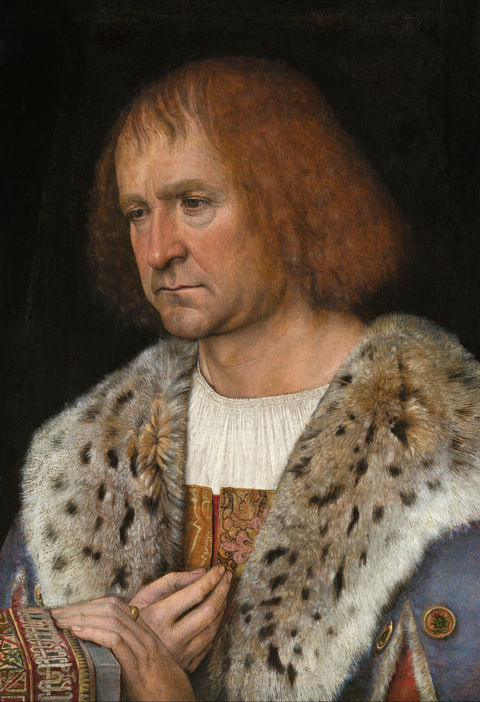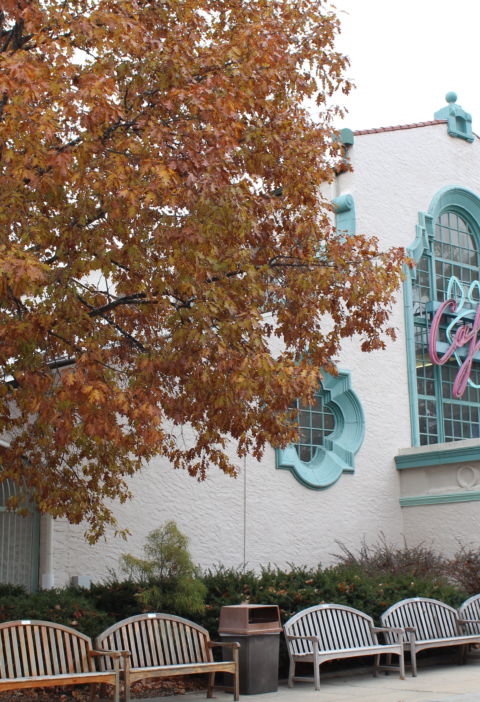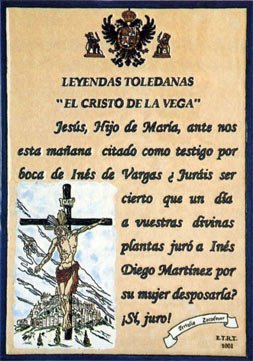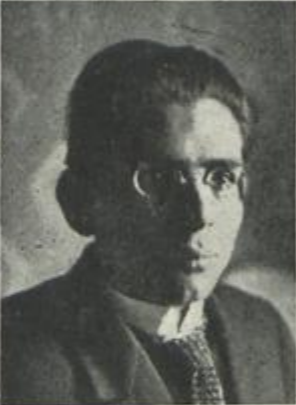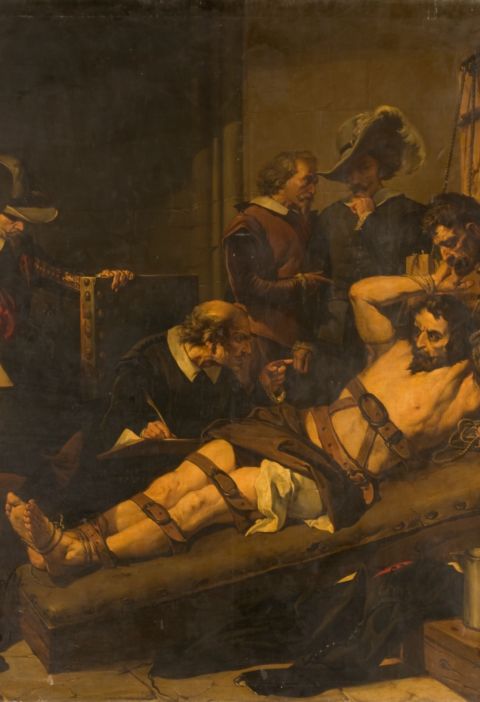Anyone who comes to visit the city of Toledo, apart from the monumental heritage that the city treasures and the beauty of the old part of the city, cannot say that they have visited Toledo if they have not heard at least some of its hundreds of legends that hide the streets and monuments.
Many are famous, or belong to world-renowned writers who walked around this city at some point, being bewitched by its secrets and mysteries. Other legends, not so much, but equally important and interesting to know.
A guided tour passes under the Shed of Santo Domingo el Real, in Toledo
Legends also help us to understand the history of a place, its traditions…, and even more so in a city that is a melting pot of the three cultures, such as Toledo.
Although all the legends end up being fabulous, magnified making them have that touch of unreality, in the background they contain real stories that the city itself could well have lived.
We will review, for the traveler who enters a few days to know this wonderful city, its ten most important legends. Ten legends that you can not miss. Ten legends that you cannot leave without, at least, having passed through those places where they are located and having read them (or heard them in some route of Toledo legends) under the tenuous lantern of a cobblestone street, under the sheds of the city, or under the cross of the façade of a convent with the silence that in that place is breathed as a witness.
Toledo Cathedral
Index of Contents
1. The golden garlic
We begin in one of the most emblematic buildings of Toledo and its skyline : Toledo Cathedral. This immense monument is full of stories and legends. But if we had to highlight one, it would be “La ajorca de oro”, by Gustavo Adolfo Bécquer.
The legend tells the story of María Antúnez, a woman the writer describes as capricious and who always wished to wear the best clothes and jewellery in order to attract the attention of the residents of the city of Toledo. It is said that her lover, Don Pedro Alfonso de Orellana, found her crying one afternoon.
She confessed to him that, having been in the temple, where the feast of the Virgin was celebrated, she had fallen in love, more than the beauty that the image gave off, with the ajorca that the Virgin wore on her arm.
Faced with this, and in order to please his lover, Don Pedro had no choice but to give in to his lover’s request to enter the cathedral to steal such precious jewel and give it to her.
Bécquer tells us that when he took advantage of the silence and darkness that the city gave him, he entered the walls of the building.
Walking through the immense naves, fearful of the shadows cast by the few lit candles that seemed to follow him, he finally arrived before the image of the Virgin of the Tabernacle. Using strength and courage, but at the same time fearful of what he was going to do, he managed to stand at her height and, stretching his arm, he managed to snatch her away so longed for bracelet.
The problem came later. When he turned to run out of the cathedral with his goal accomplished, all the statues, with their robes, had come down from their pedestals and surrounded him, along with the skeletons from the crypt. Everyone wanted to avoid such an evil misdeed.
The next morning, when they opened the temple, they found Don Pedro, lying on the floor, completely mad and shouting: “Yours it is! at the same time as he was holding up the gold bracelet with his hand.
- Location : Toledo Cathedral.
- Read full version: La Ajorca de Oro, Gustavo Adolfo Bécquer
The so called “Pozo amargo” in Toledo is not the original that appears in the legend…
2. The Bitter Well.
One of the best known love legends of the city of Toledo and one of the most romantic places in the city.
Legend that tells us about the clandestine loves of the Christian Fernando and the Jewish Rachel. The well in Rachel’s garden witnessed this love. Yet another witness watched them from the shadows: Rachel’s father.
One of those nights, when both were sharing gestures of affection and animated conversation, the Jewish woman’s father burst into the love scene, stabbing the Christian in the back with a sharp dagger, who fell to the bottom of the well with hardly any time to take a last look at his beloved.
So many tears were shed every night by Rachel on the waters of the well, in memory of that love, that the waters began to be bitter, as if they were accomplices of that bitter memory that in its day was so beautiful and that now was the strongest of pains.
In fact, one of those nights that she went to remember her lover, the pain she felt made her imagine that her lover was calling her from the bottom, which made her go to help him and throw herself to the bottom with him. From that moment on, it is said that they both rest together at the bottom of their waters.
- Location : Bitter Well.
- Read full version:The Bitter Well
 Tower of the Church of the Saints Justo and Pastor of Toledo
Tower of the Church of the Saints Justo and Pastor of Toledo
3. The Christ of the Knives.
Legend of love, whose location is in the Plaza de San Justo, in front of the Church of Santos Justo y Pastor, very close to the Cathedral at a turbulent time as was the reign of Henry IV and where noble families fought for royal power.
Legend has it that one night, Don Diego de Ayala was on his way to the Plaza de San Justo to meet his beloved Doña Isabel, a neighbor of that place.
Don diego when he arrived at the square and, as a good Christian, he made a brief prayer to the Christ of Mercy that was on the façade of the church. Just then, he began to hear the voices of a woman who seemed to be in danger, coming from one of the alleys next to the church. Raudo, went out in search of that lady.
When Don Diego entered one of the nearby alleyways, he could see a lady, who was being attacked by several gentlemen. To her surprise, this lady was Doña Isabel, her lover, and those who attacked her, the Silva, bitter enemies of her family. She had no choice, although she knew that there was little she could do, she had to save her beloved from the hands of those evil.
They were surrounded in the corner of the Church, under the Christ of Mercy to whom he had previously dedicated a prayer.
Giving himself for dead, he asked Christ that if anyone had to die, it should be him, since his beloved was not to blame for the confrontations of their families. And just at that moment, the wall on which they rested opened as if it were a curtain, and swallowed inside the temple the couple in love.
The Silva did not have the same fate: the wall became stone again, and no matter how many swords they struck, they got nothing.
So, quickly, they went to the main gate to try to force it and hunt them down. But the church bells began to ring so loudly, that the neighbors came out frightened by the hours, and if you work a fire in one of the houses in the neighborhood.
The Silva, before this, ran away and the neighbors, wanting to verify that everything was correct, accompanied by the priest they entered the church and, indeed, everything was intact except for a small detail: behind the altar, crouching, this couple, and everyone understood that what had happened there had been a miracle: they were saved by the Most High from certain death. All were celebrations.
- Location : Church of the Saints Just and Pastor.
- Read full version:The Christ of the Knives

4. The Christ of the Skull.
In a typical Toledano alley with a certain charm and close to the Alcázar, we find another of the most famous legends of Toledo and Bécquer: the street of Cristo de la Calavera. In the centre of it, a ceramic plaque alludes to the extensive legend.
The legend could be summed up in the loves of two gentlemen, Don Lope and Don Alonso de una dama, Doña Inés de Tordesillas, main lady of the court. They say that during a celebration, Doña Inés dropped one of her gloves and both gallants, quickly, rushed to pick it up and return it to her. The problem is that they pick it up at the same time, each one at one end.
None of them wanted to let go of the glove. Returning the glove to Doña Inés would be like a gallant act by means of which to be able to demonstrate his love to her, and thus to demonstrate that he was chosen to finish with her the night.
Everyone was watching the scene, paralyzed. Both had declared their love for the same woman.
A third hand had to intervene, it was the hand of the King, who snatches the glove from them and returns it to Doña Inés, not without first foretelling what could well happen: “Have the glove, and keep it well, lest one day it be returned to you stained with blood.
I’m sure you’ll also be interested: The signature or graphite of Gustavo Adolfo Bécquer on the cover of the convent of San Clemente in Toledo.
Both friends, Don Lope and Don Alonso, had realized that there was only one way to discern who would stay with Doña Inés: a duel. So they just didn’t look at each other again, and at the end of the celebration they looked for a secluded place where they could carry it out, and that would accomplish two things: that it would be ample to be able to fight in a duel (something complicated in Toledo) and that it would have some light.
They found a street with a small widening, very close to Zocodover, which also had a christ illuminated by a candle. So, without a word, the duel began.
The problem, says Bécquer, was that when the steels hit the light of the candle, it would go out and come back to light itself. Strangely enough, they did not understand the origin of this mystery.
They followed theirs, but the third time they hit their steels, the light went out abruptly so as not to ignite again and a strong wind knocked them to the ground. Then they realized that perhaps it was a divine sign that was trying to tell them to fix that in another way. That is why they agreed to go to Doña Inés’s house, and let her say which one of them she wants to stay with.
Already approaching dawn, when they are arriving at Doña Inés’s house, on their balcony they can see how a man stood down for him and she fired him with affectionate phrases. The two gentlemen burst into a loud laughter, for they understood that she had laughed at his true love. The young woman heard the laughter and quickly went into her room, closing the balcony.
The next morning, a parquet floor in Zocodover to fire the troops who were going to battle against the Moors. At the head of the parquet the queen and, next to her, donates Ines for being one of the main ladies.
She hoped to see the winner of the duel, but what would not be her surprise when, behind the King, these two friends went and, passing in front of her, they burst into the same laughter as the night before while looking at her.
She understood everything, and fell disturbed at the queen’s feet.
- Location : Calle Cristo de la Calavera.
- Read full version:The Christ of the Skull, Gustavo Adolfo Bécquer

5. Hell’s Alley.
Now let’s go with a mystery… Although just seeing the name of the Hell’s alley or the Devil’s alley will make our hair stand on end, and even more so if we walk these two streets at night. Everyone wonders why these names are here.
Legend has it that a noble Christian from Toledo, Felipe Pantoja met a witch from Toledo, known as “la Diablesa”. His objective: he needed a spell to finish off a competitor: Samuel, Rebecca’s suitor and the one Felipe Pantoja wanted to finish with, ended up dying because of the spell prepared by “la Diablesa” and Felipe manages to marry Rebecca with the church of San Torcuato as a witness.
After this, Felipe Pantoja had to pay a high price in gold coins to the witch from Toledo. But when the coins touched the old witch’s hands, white and blue flames began to emerge from her hand and the rest of her body and a loud shriek flooded the room where they were and ended up consuming her worn body.
At the same time. Felipe Pantoja was pushed by a supernatural force to the ground outside the witch’s house.
Believing himself dead, he saw his terrified reflection in a puddle and fled from that dreadful place, leaving behind his fifty gold coins.
Because of this strange and mysterious event, they decided to give both names to the two nearby streets: the alley of hell, where it is said that the house of the witch and the alley of the devil were.
- Location : Hell Alley.
- Read full version: Hell’s Alley
 The statue of Garcilaso de la Vega, looking towards the Convent of St. Peter Martyr
The statue of Garcilaso de la Vega, looking towards the Convent of St. Peter Martyr
6. The kiss.
Another of the famous legends that we find in the city and that Gustavo Adolfo Bécquer wrote. Located in the convent of San Pedro Mártir, today Faculty of Law and Business, belonging to the University of Castilla-La Mancha. We also like to emphasize that, inside, we have buried another important writer: Garcilaso de la Vega. It is located in the church of the convent, where we find other burials and where the legend is located that we pass to narrate.
When Napoleon’s French army invaded the city of Toledo (1808-1812), they began to occupy places to settle in the city, including convents and churches. A large group of soldiers were accommodated in the Convent of San Pedro Mártir, one of the largest buildings in the city, located in the heart of the city, not far from the Cathedral. They spent the first night there.
The next morning, the capital of this troop that was staying in this convent, was summoned to Zocodover Square to meet with other classmates, who knew he was in Toledo. When they were asked how the night had gone, the captain told them that it had been a long night, that he had not been able to sleep because of the cult of being next to a beautiful lady, a woman who was immobile in front of him all night and who neither saw, spoke nor listened.
It was clear that he was referring to a marble sculpture but that, due to the perfection of his sculptor at the time of carving it, it seemed to come to life. Laughter resounded throughout Zocodover Square, and everyone agreed to go that night to meet this beautiful lady.
When the time came for the meeting, everyone went to the church of the convent where the captain and the rest of the troop were staying.
They lit a fire in the centre, as the night was quite cold and, opening a few bottles of wine, they prepared to spend the night.
When the wine made its effects, the captain, half staggering, went to the stone tomb of his beloved, Doña Elvira. He took one more sip of the wine and, without thinking about it, brought his lips closer to the cold stone lips of Doña Elvira. Her companions warned her to stop playing with the dead and let them rest.
Just as his lips rubbed, the stony hand of the statue of the warrior next door struck him so hard that he shot himself into the ground. The warrior was her husband and they both rest together for eternity in the church of the Convent of San Pedro Mártir.
- Location : UCLM University Campus, San Pedro Mártir building, in its church.
- Read full version: The Kiss, Gustavo Adolfo Bécquer

A guided tour passes under the Shed of Santo Domingo el Real, in Toledo
7. The three dates, by Gustavo Adolfo Bécquer.
If you ask yourself which is one of the most beautiful areas of Toledo, we would answer that the conventual area of Toledo, where the most spectacular sheds of the city are and where these roofed streets have their charm, especially at night. Away from the tourist centre and the bustle of the night, we encourage you to go into these alleys to reach a square, the Plaza de Santo Domingo el Real, where the convent of the same name is located and where we find a dedication to Gustavo Adolfo Bécquer. In addition, here, we find one of its most famous legends.
The legend of the three dates, not “of the three arrows”, as you can read there…
Bécquer tells us that, on one of his first visits to the city, every time he went to San Juan de los Reyes, he passed through a beautiful, narrow, typical Toledo street, with windows of beautiful bars and lattices and that, almost always, he was lonely, not finding anyone along the way.
However, one of the evenings that he passed through there again noticed that, in a window framed in an ogival arch, there was a shadow of what appeared to be a beautiful lady who could be sensed behind a white curtain.
He imagined that behind her would be the most beautiful woman he had ever met and, before leaving a few days later for Madrid, in his travel notebook he wrote down that date, with the title “la ventana (the window)“.
After several months away from the city, he had the opportunity to return. He would take the opportunity to see all those places that attracted his attention. And, as it could not be otherwise, one of those obligatory places was that street where, behind the window, was found that lady who made her imagination so much fly.
In this case he could see how, behind the white curtain, captivating eyes were watching his steps. And again Bécquer, before leaving Toledo, again wrote down a second date, which he titled “la mano (the hand)”.
After some time in Madrid again, he decides to return to Toledo. And as was his custom, one of the first things he did was go through that window that had him in love. But that day he found it closed. That day he couldn’t notice the other person behind him or how someone was watching him. That day, only the walls of that narrow alley watched him. So, desolate, he managed to pass through this square of Santo Domingo el Real, where the doors of the convent let out murmurs and songs. He wanted to go inside to see what celebration it was and he could see that a nun was taking the habit. What was his surprise when the nun, looking at the door in one of her last looks at the world she was about to leave, Bécquer recognized that face and those eyes. They both looked at each other, and understood that their love was going to be impossible. Becquer left the convent desolate, trying to repress the tears his heart sent him.
I’m sure you’re also interested: La tertulia de los muertos, legend of Toledo Cathedral.
That day, Bécquer did not take the date into account and did not write it down. That date remained engraved in a place from which it would never be erased: his broken heart.
- Location : Plaza de Santo Domingo el Real.
- Read full version: The Three Dates (Gustavo Adolfo Bécquer)
8. The lady with the eyes without brightness.
We return now with a legend of mystery, of terror. Taking advantage of the fact that we are in the area of Santo Domingo el Real, one of the streets that leaves this beautiful square is Calle de los Aljibes. It is in this place where we are going to locate the following legend.
The Duchess of Savoy, Catherine of Austria, prepared a great feast in her Toledano house, until many nobles from the city of Toledo came to spend a fun evening.
One of the noble guests, and protagonist of the legend was Don Sancho de Córdoba, financial advisor to the king.
Don Sancho, in the middle of dinner, could see how a lady, dressed in white and a magical beauty, moved among the attendees without raising any look of these attracted by such beauty, except his own. It seemed that, when she slid, she was in bloom.
After supper, a dance was to begin in the gardens, and Sancho had the opportunity to ask her to dance with him. She nodded, but at no time did any word come out of her mouth.
The sound of souls from the cathedral rang throughout the city and the lady, in haste, insisted that she should leave. Don Sancho, as a good gentleman, offered to accompany her to her house, because the night was cold and a lonely lady in those streets and at those hours she could be in danger.
She refused, insisted that her pages were waiting for her at the exit. But Don Sancho did everything possible so that, at least, he would take his cape with him.
The lady gladly accepted Don Sancho’s gesture and told him to go to the Aljibes alley, to the palace of the Counts of Orsino, the next day, to recover his cape. As he said goodbye, he could see that his gaze seemed to be glare-free and that his skin was colder than the night.
The next morning Don Sancho, ready to collect his cape, went to the palace. He knocked on the door and a servant of the house opened the huge gate.
He told her that he was coming to pick up the cape he had left the night before for the young lady who lived there. After the description of the cape, the old servant told her that no lady lived there and that the lady he was describing had died several years ago.
When he was about to leave the house, thinking that he had been deceived the night before, he could see the picture of a beautiful lady they had in the hallway of the house. It was the same lady as the night before, the lady to whom he lent his cloak. He insisted again that she was the same lady as the night before, offending the old man and the family residing there.
He came out of the house strangely and without understanding anything. Who, then, was the lady to whom he lent his cloak the night before?
The next morning, while Don Sancho was at home suffering from a strange ailment and having constant sweating, someone knocked on the door.
When he opened the door, he was the old servant of the night before, of the house of the Counts of Orsino.
He held his cape in his hand and, while handing it to him, said: “I found it this morning, in the Cemetery, above the tomb of the Countess of Orsino”.
- Location : Calle Aljibes.
- Read full version:The Lady with the eyes without brightness
 Interior of one of the towers of San Servando Castle
Interior of one of the towers of San Servando Castle
9. The death of the Templar Nuño Alvear.
Any traveller who approaches the city of Toledo from the Madrid area will be able to see the majestic castle of San Servando which rises on a hill near the Alcántara bridge. A Templar fortress that today functions as a youth hostel. Here we will locate another legend of mystery and terror.
It is said that, on a cold night, part of the Templars who inhabited the castle were guarding the walls and doors of the fortress. One of the guardians was Nuño Alvear, a Templar with a bad reputation in the city of Toledo for the atrocities he had committed not only among his companions but also among the rest of the neighbours.
Seeing that it was late at night, he decided to retire to rest for a while, to the living room, to the heat of the chimney. He was almost falling asleep when a few knocks on the main door of the castle frightened the guard and unveiled him. He ran down to see what it was all about, to see if it was some pilgrim looking for shelter from that cold night.
When he went down to the door, a Templar had already opened it and I can see that it was an older woman, dressed in black, covered with a handkerchief of the same color.
When he was alone with Nuño, he told her that if he didn’t remember her.
Nuño didn’t understand what he meant. She presented herself as Death, who had come for him for all the evil he had done. And if he remembered nothing of his misdeeds, he only had to look at the fire in the chimney where, among the flames, images of his many misdeeds began to be shown, as if by the art of dark magic.
The next morning Nuño Alvear’s body was found lying on the floor in front of the chimney, dead.
It is said that, since that day, the spirit of Nuño Alvear continues wandering through the castle, crying out for revenge for that unexpected visit that came to the castle.
- Location : San Servando Castle.
- Read full version:The death of Don Nuño Alvear, a Templar legend from Toledo
The Templars, one of the most popular guided tours of Routes of Toledo.
10. The Toledan night.
We end with one of the most famous legends of the city and that has given rise to the phrase that many of us pronounce everywhere: “What a night I spent in Toledo!”, a phrase that we use when, above all, we have not had a good night, it has been hard to fall asleep for some reason…
In the Paseo de San Cristóbal, a privileged place with the Jewish quarter at its feet, we find this legend that you should know if you approach the city.
In the city, in the year 190 of the hegira, Jusuf-ben-Amru, despot and cruel to all Toledans, committed multiple misdeeds under his power: he kidnapped maidens, and killed anyone who opposed his terrible methods. All the inhabitants of the city were dissatisfied with the way he was governing.
One night, a popular revolt, he decided to put an end to this bitter regent. A group of people snuck inside the citadel where he was and ended Jusuf’s life, putting an end to the atrocities he was carrying out.
But when everyone thought the problem was over, the governor who came to the city to take the place left by Jusuf was his father.
All the Toledans began to tremble with fear, thinking that the first thing he would do would be to avenge his son’s death. Although, to his surprise, he tried to run a quiet government, implying that he had forgotten what they did to his son and that he wanted there to be peace in the city.
At the end of time, it seems, that those who surrounded him in his citadel began to poison his thoughts, to make him see that he had to avenge the death of his son, whom all the Toledans had laughed at so cruelly when they ended his life.
So, taking advantage of the fact that the son of the Califa Albderramán III was to pass through Toledo on his way to Zaragoza, he decided to hold a dinner and invite many nobles from the city of Toledo.
The problem was that, when they arrived that night, when the nobles approached the palace with their best clothes and thinking that they were going to fill their stomachs with good food, when they crossed some wide curtains that gave access to the patio where the dinner was going to take place, sharp knives cut off their heads, which were hung at the top of the palace so that, on seeing them there, the rest of the city would have an important lesson for the painful death of their son.
That night no one slept a wink, fearing that their doors would be opened to continue passing the knife to the rest of the city as just revenge for what they did to their son. Hence the famous phrase we all use.
- Location : Paseo de San Cristóbal.
- Read full version: A night in Toledo



